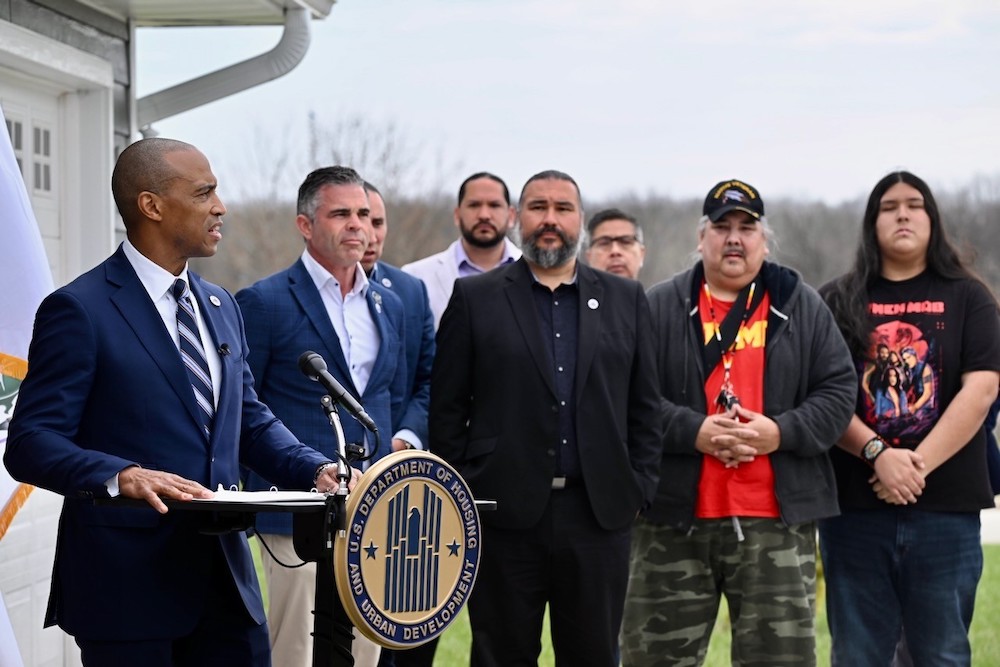
- Details
- By Scott Turner, HUD Secretary
Guest Opinion. Homeownership is a cornerstone of the American Dream. For many communities, including tribal communities, the path to homeownership has been filled with challenges.
Across Indian Country, Native American families are working to overcome barriers to homeownership such as limited access to credit due to the complex status of tribal land. These barriers result in higher interest rates, overcrowding, deficient housing stock, and scarce opportunities for building generational wealth.
At the U.S. Department of Housing and Urban Development (HUD), we are addressing roadblocks to Native American homeownership and improving systems to meet the growing demand for affordable homes.
We want tribal communities to know that HUD is committed to expanding homeownership opportunities on their reservations.
As HUD secretary, I’ve been blessed with the opportunity to visit tribal lands and witness firsthand the powerful impact of homeownership across Indian Country. During my visit to the Oneida Nation in Green Bay, Wisc., I met a veteran who shared that homeownership gave him more than a roof over his head – it provided the stability he needed to pursue job opportunities and help his son graduate from high school.
A home anchors families and strengthens communities—and HUD’s Section 184 Indian Home Loan Guarantee Program helps tribal communities build these foundational roots through access to the financial tools needed for homeownership.
Since the program began in 1992, HUD has facilitated more than $10.5 billion in investments across tribal communities, opening up a pathway to homeownership for over 58,000 tribal members. By offering a 100% guarantee to lenders, flexible underwriting, low down payments, and reduced fees, Section 184 acts as a catalyst for economic growth on tribal lands and breaks down bureaucratic barriers to homeownership for Native Americans.
At HUD, we are working with stakeholders and tribal leaders to swiftly and effectively modernize the program, increase efficiency, and foster robust housing and lending ecosystems for Native American communities. These collaborations have led to important refinements to Section 184, expanding access to homeownership opportunities and turning the dream of owning a home into a reality for more families across Indian Country.
This modernized program does more than simply support individual tribal members. Eligible borrowers also include tribes and Indian Housing Authorities that can use the single-close construction feature to carry out large-scale developments, which will increase their housing stock without income restrictions. These loans can then be assumed by tribal members, allowing them to link their business and economic development goals with their housing initiatives. This creates a cycle of economic resilience grounded in stable homeownership, which lays the foundation for generational wealth.
For example, through Section 184, a family in the Navajo Nation was able to purchase a $150,000 home. They invested sweat equity into renovating their new house, and as the market grew, so did their equity. Eventually, this family was able to purchase a home worth nearly a half-million dollars. What began as a modest start under the Section 184 program turned into a generational asset that this family can pass on to their children and grandchildren.
Homeownership means economic opportunity. Economic opportunity means generational stability. And generational stability means a lasting and prosperous future for Native American communities.
As we celebrate National Homeownership Month, I am committed to strengthening our Section 184 program, which has become the lowest-cost, lowest-risk and highest-impact mortgage product for Indian Country today. By empowering tribal families to invest in stable housing, Section 184 fuels local economic development, strengthens tribal communities, and preserves cultural ties to land.
Under President Trump’s leadership, we will boost economic and community development in all communities—rural, urban, and tribal—and promote pathways to homeownership for all Americans.
I am proud to share that HUD has already helped tens of thousands of Native American families achieve the American Dream of homeownership. We stand ready to help tens of thousands more.
Scott Turner is the 19th secretary of the U.S. Department of Housing and Urban Development.
Help us defend tribal sovereignty.
At Native News Online, our mission is rooted in telling the stories that strengthen sovereignty and uplift Indigenous voices — not just at year’s end, but every single day.
Because of your generosity last year, we were able to keep our reporters on the ground in tribal communities, at national gatherings and in the halls of Congress — covering the issues that matter most to Indian Country: sovereignty, culture, education, health and economic opportunity.
That support sustained us through a tough year in 2025. Now, as we look to the year ahead, we need your help right now to ensure warrior journalism remains strong — reporting that defends tribal sovereignty, amplifies Native truth, and holds power accountable.
 The stakes couldn't be higher. Your support keeps Native voices heard, Native stories told and Native sovereignty defended.
The stakes couldn't be higher. Your support keeps Native voices heard, Native stories told and Native sovereignty defended.
Stand with Warrior Journalism today.
Levi Rickert (Potawatomi), Editor & Publisher
